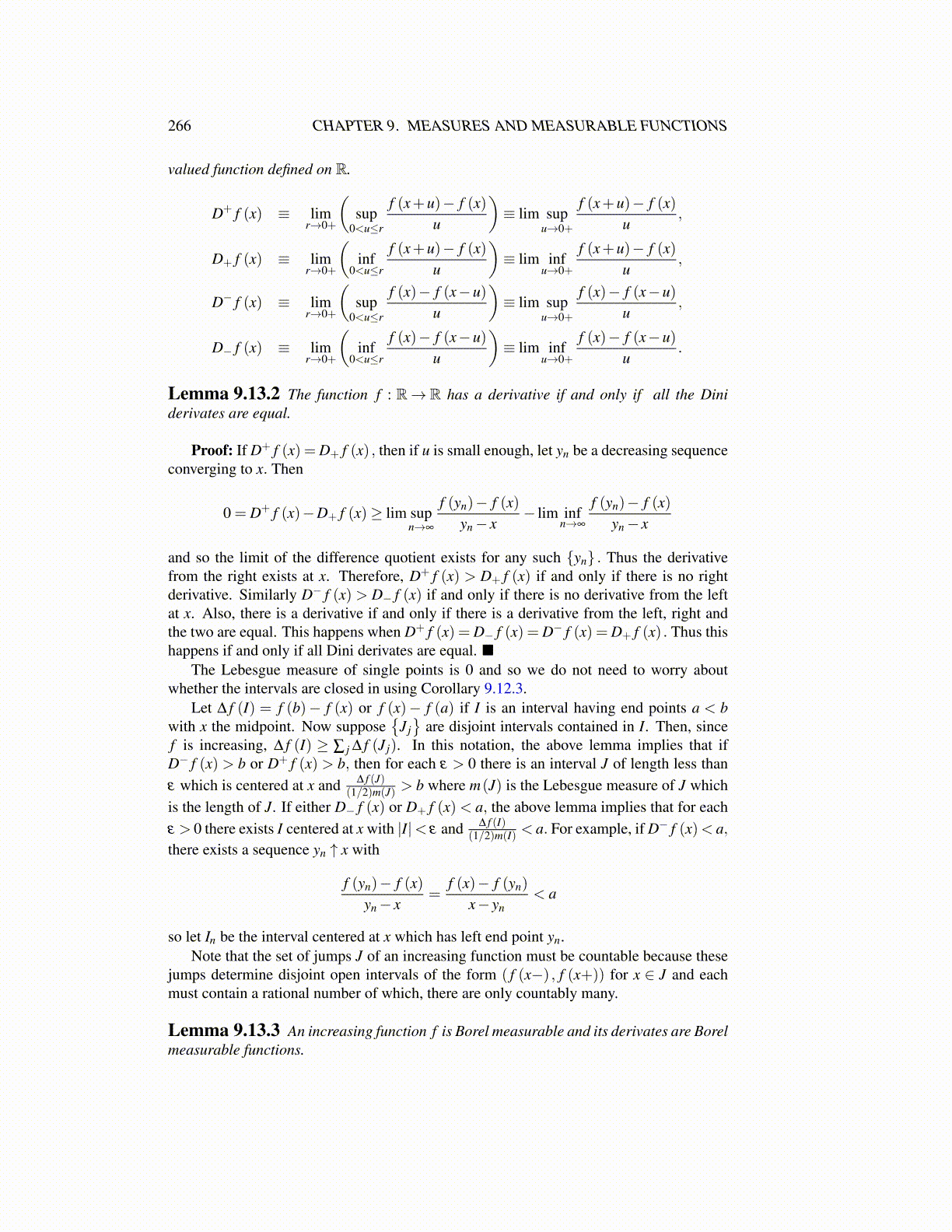
266 CHAPTER 9. MEASURES AND MEASURABLE FUNCTIONS
valued function defined on R.
D+ f (x) ≡ limr→0+
(sup
0<u≤r
f (x+u)− f (x)u
)≡ lim sup
u→0+
f (x+u)− f (x)u
,
D+ f (x) ≡ limr→0+
(inf
0<u≤r
f (x+u)− f (x)u
)≡ lim inf
u→0+
f (x+u)− f (x)u
,
D− f (x) ≡ limr→0+
(sup
0<u≤r
f (x)− f (x−u)u
)≡ lim sup
u→0+
f (x)− f (x−u)u
,
D− f (x) ≡ limr→0+
(inf
0<u≤r
f (x)− f (x−u)u
)≡ lim inf
u→0+
f (x)− f (x−u)u
.
Lemma 9.13.2 The function f : R→ R has a derivative if and only if all the Diniderivates are equal.
Proof: If D+ f (x) = D+ f (x) , then if u is small enough, let yn be a decreasing sequenceconverging to x. Then
0 = D+ f (x)−D+ f (x)≥ lim supn→∞
f (yn)− f (x)yn− x
− lim infn→∞
f (yn)− f (x)yn− x
and so the limit of the difference quotient exists for any such {yn} . Thus the derivativefrom the right exists at x. Therefore, D+ f (x) > D+ f (x) if and only if there is no rightderivative. Similarly D− f (x) > D− f (x) if and only if there is no derivative from the leftat x. Also, there is a derivative if and only if there is a derivative from the left, right andthe two are equal. This happens when D+ f (x) = D− f (x) = D− f (x) = D+ f (x) . Thus thishappens if and only if all Dini derivates are equal. ■
The Lebesgue measure of single points is 0 and so we do not need to worry aboutwhether the intervals are closed in using Corollary 9.12.3.
Let ∆ f (I) = f (b)− f (x) or f (x)− f (a) if I is an interval having end points a < bwith x the midpoint. Now suppose
{J j}
are disjoint intervals contained in I. Then, sincef is increasing, ∆ f (I) ≥ ∑ j ∆ f (J j). In this notation, the above lemma implies that ifD− f (x) > b or D+ f (x) > b, then for each ε > 0 there is an interval J of length less thanε which is centered at x and ∆ f (J)
(1/2)m(J) > b where m(J) is the Lebesgue measure of J whichis the length of J. If either D− f (x) or D+ f (x)< a, the above lemma implies that for eachε > 0 there exists I centered at x with |I|< ε and ∆ f (I)
(1/2)m(I) < a. For example, if D− f (x)< a,there exists a sequence yn ↑ x with
f (yn)− f (x)yn− x
=f (x)− f (yn)
x− yn< a
so let In be the interval centered at x which has left end point yn.Note that the set of jumps J of an increasing function must be countable because these
jumps determine disjoint open intervals of the form ( f (x−) , f (x+)) for x ∈ J and eachmust contain a rational number of which, there are only countably many.
Lemma 9.13.3 An increasing function f is Borel measurable and its derivates are Borelmeasurable functions.